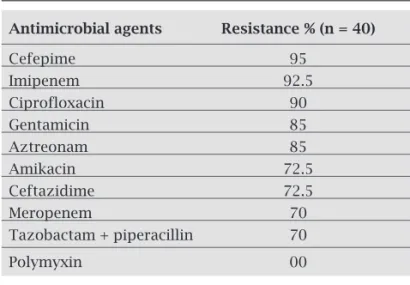Pseudomonas aeruginosa in intensive care units in
Texto
Imagem


Documentos relacionados
Objectives: To describe the clini- cal features and outcomes of patients admitted with inluenza A (H1N1) infection in two private hospitals’ in- tensive care units in São
Physicians in neonatal, pediatric and mixed ICUs in the state of Rio de Janeiro have inadequate training in intensive care medicine, especially in pediatric intensive care,
he Acute Physiology and Chronic Health Evaluation (APACHE) is the most frequently used general severity-of-illness score in adult intensive care units (ICUs).. APACHE scores
Objective : To assess use of stress ulcer prophylaxis in patients admitted to ive pediatric intensive care units (PICUs) in Porto Alegre, Brazil.. Methods : This was a
In a cross-sectional (one-day prevalence) study carried out in 19 intensive care units (ICUs), with a combined total of 170 beds and 126 admitted patients, of a university hospital
A survey was conducted in two pediatric intensive care units in hospitals in Porto Alegre, Brazil, in order to monitor the main respiratory viruses present in bronchiolitis
This study was conducted to determine the antimicrobial susceptibility patterns among common pathogens in the intensive care units (ICUs) of a university hospital in
his is a prospective study of emergency EEGs ob- tained from patients submitted to urgent examinations in the Emergency Department, on the ward or in inten- sive care units (ICUs)